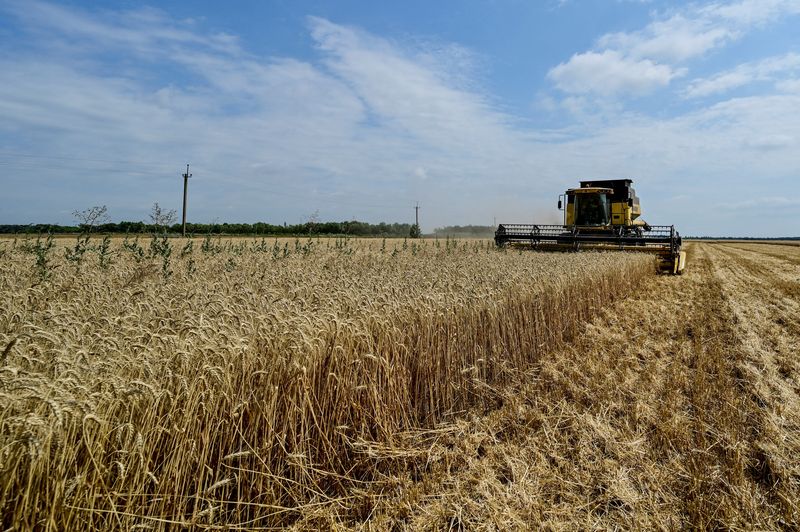Ukraine’s farmers pin hopes on export corridor as war cost mounts
2023.11.23 01:57
2/2

© Reuters. FILE PHOTO: An agricultural worker operates a combine during a wheat harvesting in a field, amid Russia’s attack on Ukraine, in Zaporizhzhia region, Ukraine July 14, 2023. REUTERS/Stringer/File Photo
2/2
By Pavel Polityuk and Gus Trompiz
KYIV/PARIS (Reuters) – Ukraine’s efforts to revive sea exports in defiance of Russia’s military blockade have given a glimmer of hope to a teetering farm sector in which loss-making producers are abandoning some land in one of the world’s biggest grain belts.
With no end in sight to the war with Russia, access to the Black Sea is critical if Ukraine is to preserve an agricultural industry that was the fourth-largest grain supplier globally before the conflict and in value terms accounted for half of Ukraine’s total exports last year.
While makeshift export routes and abundant supply elsewhere have tamed record global food prices since last year, the strain on Ukrainian agriculture has worsened as a UN-backed export deal collapsed and EU neighbours baulked at land shipments.
Agriculture has suffered losses of over $25 billion since the war began, Ukrainian grain trader association UGA estimates.
Ukraine’s grain exports so far in the 2023/24 season that started in July are running 28% below the year-earlier volume, according to agriculture ministry data.
The area planted with corn, its flagship grain export, has shrunk by a quarter since the start of the war and total crop planting could suffer a double-digit decline in 2024, producers say, as cash-strapped farms leave some land idle.
A new Black Sea shipping channel may offer a lifeline, like for Ukraine’s depleted steel industry.
“The sea corridor is essential for Ukrainian farming to survive,” Jean-Francois Lepy, head of grain trading at French agribusiness group InVivo, said.
“Without a corridor there is going to be a serious problem in 2024/2025,” he said on the sidelines of this month’s Global Grain conference in Geneva.
The “humanitarian corridor” established by Ukraine’s military in late August has expanded steadily, with Kyiv estimating over 3 million tons of grain shipped so far.
Its future remains clouded by military risks, with several vessels struck by mines or missiles, but Ukrainian producers are encouraged.
“It gives us breakeven because before the ports opened almost everyone was loss-making,” Dmitry Skornyakov, CEO of farm operator HarvEast.
EXPORT ROUTES
Ukrainian producers see scope to reach 2-2.5 million tons of monthly grain exports through the corridor, which combined with volumes through land routes and transhipment via the Danube river could bring overall trade back towards a pre-war rhythm of 5-6 million tons per month.
Spike Brokers, which tracks exports in Ukraine, said on Nov. 1-17 Ukraine exported 404,000 tons of agricultural goods via the Danube and 352,000 tons from Black Sea ports. An additional 943,000 tons should leave from Black Sea ports and 464,000 tons from the Danube by the month-end.
“The situation in the coming months will be better than in September and October, as large ships are starting to arrive and the number of insurance companies that insure risks is growing,” said Denys Marchuk, deputy head of the Agrarian Council, Ukraine’s largest agribusiness group.
Some in the market are cautious given the still perilous security situation. A Russian missile strike on port infrastructure in Odesa on Nov. 21 added to a series of attacks on Ukraine’s Black Sea and Danube grain ports.
Despite expansion at Romania’s Constanta port, trade via the EU remains dogged by logistical bottlenecks and tensions with Kyiv’s neighbours. Border protests by Polish lorry drivers have slowed food exports this month.
PLANTING DILEMMA
The new growing season could be a tipping point.
Winter wheat sowing will be down almost 10% on year, Ukraine’s agriculture ministry estimates, with a dry start to autumn adding to farmers’ problems.
HarvEast plans to leave uncultivated more than 10% of the 34,000 hectares it currently operates as it sacrifices less fertile fields seen as generating more losses, Skornyakov said, forecasting a general trend of 10-20% of unplanted land next year versus 3-5% this year.
Yuriy Stelmakh, a grower in northern Ukraine, said his farm drilled 30% less area with winter crops due to a lack of funds.
Ukraine’s agri-food industry is trying to adapt. Farmers have planted more oilseed crops like sunflower that can offer better margins, while high world sugar prices and cheap local grain to feed poultry have spurred exports of those products.
But as the war drags on, the sector faces a lack of visibility, labour shortages and structurally low prices, said Roman Gorobets, director of FE ASTRA in central Ukraine.
A huge wheat surplus in Russia and record corn and soybean harvests in Brazil have helped the world adapt to stop-start Ukrainian exports. A trade gap may be felt next year, though, if weather hits Brazilian crops and the Kremlin intervenes further in Russian exports.
Ukraine has sharply reduced exports of farm goods to Asian and African countries this year, according to agricultural business association UCAB.
Major importer Egypt has various supply sources for wheat, but few alternatives to Ukraine for corn and vegetable oil, Hesham Soliman, president of Egyptian merchant Mediterranean Star, said.
Much hangs on the spring planting season and whether Ukrainian growers cut back further on corn, relatively costly to produce.
“I don’t think the world can afford for Ukraine’s agriculture to suffer. We do need them, particularly on the corn side,” said Scott Wellcome, director of grains risk management at GoodMills, Europe’s largest miller.








